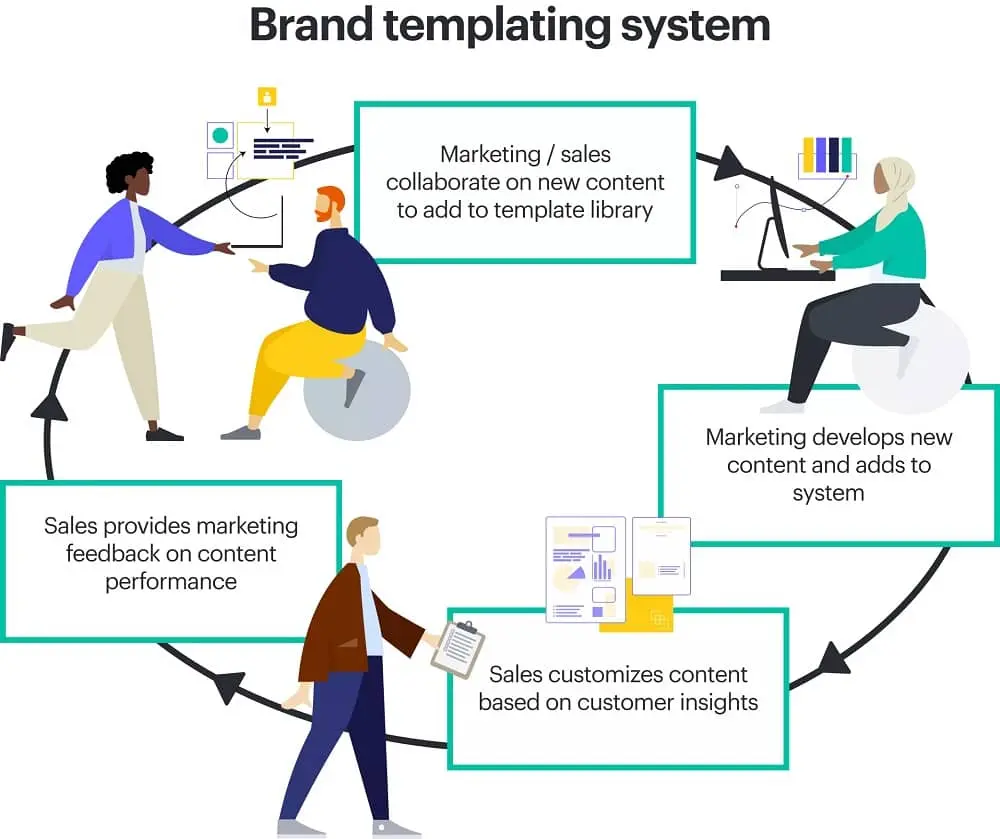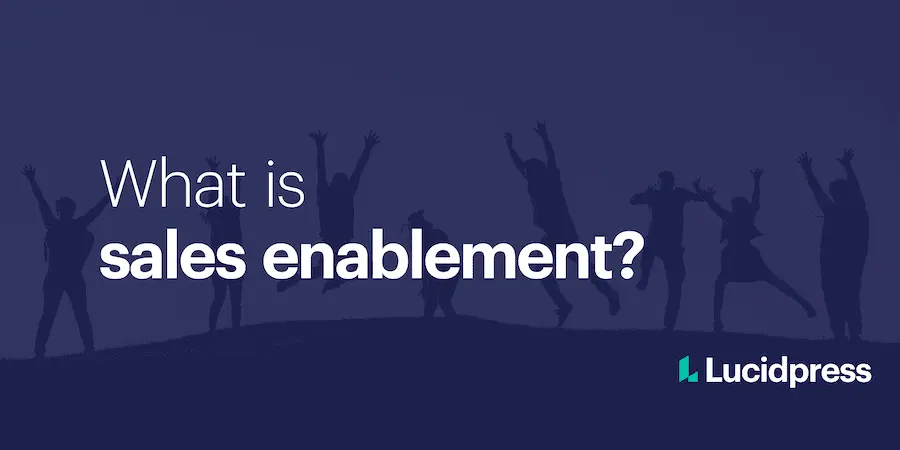If you’re anything like me, when you see a new business or marketing vocabulary word, you skim over it and make a few assumptions based on context for what it means. I recently learned how this habit is not only holding me back, but my business ventures as well.
Related: How to create engaging sales enablement content for your sales team
The term that got me? Sales enablement. This concept is fairly new and has been trending in the sales industry for a few years, but what does it mean and how is it implemented? In this guide, I will explain what sales enablement is and how you can incorporate it into your company’s sales process.
What is sales enablement?
Defining sales enablement: Sales enablement is the process of providing your salespeople with sufficient tools, resources and game plans to sell effectively.
When I first saw this phrase, I interpreted it to mean ‘the act of enabling sales.’ Real deep, I know.
Then I actually did the due diligence of conducting research and immediately felt regret for not initially recognizing the importance of sales enablement and its rightful place in sales content and the sales process itself. It’s more than a fancy buzzword — it’s a real tactic that can be formalized and followed, whether your company has one or one thousand employees.
It is the responsibility of sales managers to facilitate the success of the sales team. Part of this is done by building a sales content strategy — one that, after reading this, hopefully includes sales enablement.
It’s very likely that you as a sales manager or sales trainer have already enacted some form of this in one way or another, but by taking a deep dive into its meaning and practice, you’ll have a better defined and self-helping strategy that efficiently delivers success.
So what is sales enablement? Simply put, sales enablement is the process of providing your salespeople with sufficient tools, resources and game plans to sell effectively. This buyer-focused strategy gives the sales rep tools to engage the prospect. It is made up of outward-facing content the sales rep will provide the buyer at some point during the sales process, and inward-facing content such as information, sales training, best practice guidelines and branding.
Benefits of sales enablement
1. Maintain and improve revenue growth
A study from Aberdeen found that companies with great sales enablement strategies see a 13.7% annual increase in deal size or contract value. Sales teams benefit from having continued support and education on who their buyers are and the message that will be most impactful for that buyer. With a sales enablement program, companies offer their salespeople a constant resource for training and support rather than trying to get by with occasional training meetings.
2. Shorter sales cycles
A 2015 study found sales reps can spend up to 43 hours every month searching for information they need to make a sale. Sales enablement reduces that lost productivity and can even shorten sales cycles by allowing sales teams to focus on speaking with prospects instead of looking up case studies and finding product one-pagers.
3. Improve sales and marketing alignment
Companies with great sales and marketing alignment have 36% higher customer retention rates and 38% higher sales win rates. Yet, many organizations fail to bridge the divide between sales and marketing. Sales enablement helps bridge this gap by creating a collaborative environment for marketing to understand the needs of sales and for sales to be trained on how to use the research and content marketing provides. Sales enablement platforms also provide analytics data on what content is being used, providing instant feedback to marketing on the quality of their sales enablement materials.
4. Relevant, personalized touch points
Sales reps dealing with a long sales cycle need to establish multiple touch points with a prospect without always hopping on a call or emailing the same information over and over. Sales enablement provides relevant content for every part of the buyer’s journey, so sales reps can stay in touch by providing content that moves a prospect closer to a deal. Sales enablement also makes it easier to personalize outreach by providing a library of content tailored to various personas and industries.
5. Consistent brand messaging
Sales enablement also ensures that the messaging leads read while engaging with the website is the same messaging they hear when they get on a sales call. Given that presenting a brand consistently is attributed to a 23% increase in revenue, marketing and sales leaders would be wise to take this benefit seriously.
Who owns sales enablement?
Typically marketing and sales jointly own sales enablement. During the production process, the sales team acts as an adviser to the marketing team on what content they need and the types of questions prospects have. Marketing provides content and messaging materials based on persona research and strategic messaging and train the sales team on how to use the content. Overtime, both departments develop a continuous feedback loop to improve the sales enablement process.

Smaller companies will typically rely on a product marketer or content manager to lead out on identifying sales enablement priorities and coordinating content production. Mature companies will often hire a sales enablement manager.
Common responsibilities for a sales enablement manager include:
- Producing sales enablement content
- Training sales teams on persona research and content usage
- Measurement of programs
- Acts as a liason between marketing, sales and product teams
- Manage sales enablement tools and software
Sales operations & sales enablement
While sales enablement is a critical tool for improving sales performance, it should be seen as a distinct function from sales operations. Sales operations focuses on the day-to-day activities that help a sales team run smoothly from setting up compensation, assigning territories, contract management and recruitment to setting up sales tools like CRMs.
Sales enablement is primarily focused on optimizing sales’ interactions with prospects through optimized sequences, personalized content and optimized messaging.
Where to start with sales enablement
The first step is to define the sales objective. Because this is a buyer-focused method, this means defining your target audience. Ask yourself, who wants your product or service? Who needs it? Create marketing personas to identify your prospects’ buying habits, traits, income and expectations. (Pro tip: your marketing team may already have these ready to go.)
Next, identify what information a sales rep will need to engage the buyer. What information does your team need about your company, its products, mission or background? How do you start the initial conversation? What will push a prospect into becoming a buyer?
In today’s digital world, the most successful companies do this through compelling storytelling methods like blogs, research papers, webinars and other high-quality sales content. Remember that sales and marketing go hand-in-hand!
Sales and marketing alignment helps ensure that you can create effective content strategies that cater to the needs of both teams and, ultimately, empower you with brand consistency.
To get started, you’ll want to evaluate the following:
- Sales and marketing goals — Sales and marketing have similar goals. However, the difference lies within the time it takes to achieve these goals. For example, sales teams are driven by meeting a monthly (or quarterly) quota, which requires fast-paced flexibility and readiness at a moment’s notice. Marketing goals are less frenetic in nature. They wind up being more long-term and methodical in comparison to their sales counterparts. To achieve a happy medium between sales and marketing, you’ll want to identify overlap in goals and make specific goals surrounding that overlap to ensure success.
- Sales and marketing roles — Sales and marketing cannot be siloed into their roles: there has to be common ground between the two departments. Sales need to stretch and flex the leads that marketing supplies. Whereas marketing needs to equip sales with easy-to-use resources or content collateral that empowers them to push through quotas quickly and easily.
- Software and process crossover — Different processes and software work better for sales, and the same goes for marketing. Where you can, bridge the gap between the two by using the same processes and technology. Keep in mind — because Lucidpress is a brand templating platform, it can effectively cater to both marketing and sales, which empowers sales and marketing teams to focus on their respective goals while working together.
Your sales team must have a clear grasp on when to wield each tool. Education workshops, training sessions, best practice tipsheets, and one-on-one coaching should occur regularly to foster growth and success.
Because using the right resource at the right time is an important part of sales enablement, team members must know where to find what they are looking for quickly in the heat of battle — or rather, in the heat of a sale.
How to create sales enablement content
Sales enablement content fall in the later stages of the customer journey. In the consideration stage, content should focus on the value your product brings to the customer. As the customer moves into the decision stage, content becomes much more product-focused. Expanations of features, competitor comparisons and case studies are helpful at this stage.
Don’t forget about customer retention and renewals. Ensuring the sales team has the resources to properly set customer expectations and communicate the value you’ve provided will ensure a smooth renewal process.
This may seem like a hefty (or even overwhelming) task to take on. Work smarter by taking advantage of a brand templating platform, such as Lucidpress.
As sales managers and sales trainers, I know you wear several hats — and expert graphic designer isn’t usually one of them. Brand templates will help your team maintain brand consistency, build content quickly and easily, and store it all in one location. You will then have access to a large library of marketing and sales content templates, which are all customizable.
For example, if you wanted to create a sales enablement starter pack using only Lucidpress templates, you could edit these to showcase your company’s branding, information and guidance.
For internal use:
- Essential branding infographic
- Blue icons marketing proposal
- Business pitch presentation infographic
- Target demographics & personas infographic
For external use:
Software & templates like these are extremely helpful when defining your sales content strategy, as they already include space for sections you don’t want to miss, while still letting you control the direction your sales content takes.
Some additional sales enablement content examples:
- FAQ sheets
- Buyer’s guides
- Newsletters
- Email templates
- Technical data sheets
- Slide presentations
- Objection-handling sheet for prospecting calls
- Case studies & testimonials
- Explainer videos
- Sales scripts
Sales enablement technology
Sales enablement software generally fall into categories of content management, CRM, sales Intelligence, lead management & sales coaching. We’ve listed some examples below. Click here for the full list of software.
Lucidpress is a collaborative brand templating tool that lets your sales team and your marketing team design sales content together.
HubSpot CRM offers free tools to increase productivity, all while integrating with the other platforms you use.
Technographics provider and sales management software Datanyze helps companies use analytic insights to close more deals.
Velocify provides an easy-to-use platform for following up with leads.
Gong is a sales coaching platform that lets you replicate what your best reps are doing to lift your whole team up.
How to measure sales enablement results
Lastly, it is critical to enforce and measure various outcomes in the sales process. How long is the sales cycle for each sales rep? What is the value of each sale? How many people on your team are meeting the quota?
How well is your sales enablement content performing?
There are a few things you need to keep in mind as you create future content AND evaluate current content.
- Y / N: Is your brand being consistently portrayed?
- Y / N: Are you collaborating with other departments to ensure the content is effective and strategically aligned with the brand?
- Y / N: Is the content up-to-date and on-brand?
And no matter what type of sales collateral you create, you should answer the following questions:
- How does this material help the prospect?
- How does this material fit into the buying journey of my clients?
- What are the top 3 to 5 benefits that matter most to my clients?
If you can answer these questions, you’re on the right track to create compelling sales collateral that streamlines the process and helps your team close more deals.
If done well, each one of these metrics should show steady growth. If you are not receiving the desired results, find the weak points in the strategy. Reevaluate both the new hire sales training and routine training, determine if there is any content prospects are asking for but not receiving, and ensure sales members are leveraging resources at the correct time.
Key takeaways
To summarize, sales enablement is a formalized sales content strategy that focuses on the buyer. It consists of a series of steps:
First, outline the sales objective.
Second, create and provide your sales team with both internal & external sales content.
Third, train your sales reps regularly.
Lastly, analyze the outcome and adjust if necessary.
Now that you have a better understanding of sales enablement — well past ‘the act of enabling sales’ — you should feel more confident and prepared to build or strengthen your sales content strategy. With a strong strategy in place, your sales reps will feel empowered to achieve.
Ready to get started? Consider Lucidpress your sales enablement solution.



